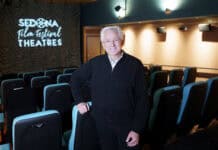Age: 61
Time in Sedona: Eight years full-time resident and six preceding as a part-time resident
Background: “My background is in government as a civil servant and an elected official. Prior to being elected to the Sedona City Council, I served for three years on the Planning and Zoning Commission. My wife and I moved here from Rhinebeck, N.Y., where I served for five terms — 10 years — as the elected town superintendent of highways. Before that I worked in New York State government as director of communication for an assembly member and, prior to that, ran a New York City agency.”
Q: How do you propose to amend, alter or repeal Sedona’s building codes to help solve the housing shortage?
A: “Many Sedonans share the goal of creating new housing opportunities in our city. Sometimes builders run into an onerous process while seeking permits or zone changes. Council and city staff recently discussed ways to spur workforce and affordable housing development by providing further incentives — several already exist — so projects might be more economically feasible.
“We need to consider if there are specific locations in the city that can absorb higher density, allow additional units and provide more cost flexibility to developers. We need to revise codes and consider what community benefits we may get back for loosening requirements for things like garages, roof line variations, building mass requirements … while preserving the character of our neighborhoods.
“Council will be reviewing revisions to the Land Development Code, the Development Incentives and Guidelines for Affordable Housing and regulations around accessory dwelling units.”
Q: Council has committed to the future use of the Sedona Cultural Park being decided by the public. What is your view on how that process should be conducted? Do you support or oppose the restoration of the amphitheater?
A: “The 40-acre Cultural Park site provides a unique development opportunity. I support an in-depth planning process that includes multiple vehicles for public participation in order to identify the needs and wants of our community. It is important that a compatible mix of uses be developed at the site.
“I do not think that a large-scale concert venue would be compatible with housing and it would bring traffic into a community that has expressed traffic mitigation as a priority.
“The community will guide what is ultimately developed through direct participation early in the planning process, as well as through more traditional platforms of public hearings and comment opportunities. If the community agrees, my wish list would include a mix of uses including a diversity of housing types; preservation of open space and views; enhanced trail access; public recreation — indoor sports facilities that can be used in all weather conditions, e.g., sport courts, swimming — inclusion of locally produced art; and recognition of our local history.
“I believe that a careful planning process can accomplish these goals and I want to see them considered.”
Q: Council has said short-term rentals are an obstacle to affordable housing in Sedona. What can council do to reduce STRs? What can council bring the median home price down to where it’s affordable for median-income residents?
A: “The explosion of single-family home conversions to short-term rentals has had an enormous impact on our community. We have lost about 17% of our housing stock to STRs. Not only has the available housing for long term rentals decreased, but the income potential of STRs has driven up property values of converted properties, in turn driving up the general property costs of the community, putting prices out of reach for many people looking for homes in Sedona.
“State law does not allow local governments to limit the use of residential homes as STRs, nor does it allow the city to set a cap on the number of STR units in the community.
“Council and staff have worked with our local state representatives to introduce bills to allow us to set a cap, while grandfathering existing units. Council and staff have advocated at every opportunity and even hired a legislative advocate expressly for this purpose.
“Unfortunately, the state legislature refused to bring forward bills from their colleagues who understand our plight. I am committed to continuing this effort until there is a legislature in place that will grant local control for these issues.”
Q: How do you suggest the city act to increase home ownership among workers?
A: “To address our housing shortage, exacerbated by the loss of long-term housing stock, the city has tried to ‘think outside the box’ by offering two different down payment assistance programs. The city also has incentives for developers proposing housing which could apply to rentals or to homes designed to be purchased including grants, loans and partnerships. Descriptions of the housing programs available can be found at sedonaaz.gov.
“Housing is not a one-size-fits-all situation. Yes, we have a shortage of traditional multi-family housing, but we should also be looking at ideas for tiny homes and for preapproved building plans that would simplify and lower costs for applicants.
“Other factors contribute to our housing shortage. To make local home ownership more attractive to our workforce, we must address not only affordability but community lifestyle. Workers need public transportation to get between their homes and jobs, broadband for home workers, community amenities that make it desirable to live here, like parks, art and culture and an environment that is friendly to families and youth.”
Editor’s Note:
There are three open seats on Sedona City Council in the 2024 election. Incumbent Sedona City Councilwoman Kathy Kinsella, challenger Derek Pfaff, incumbent Sedona Vice Mayor Holli Ploog and challenger Katherine Todd are the four candidates campaigning for three seats. Election day is Tuesday, July 30.
